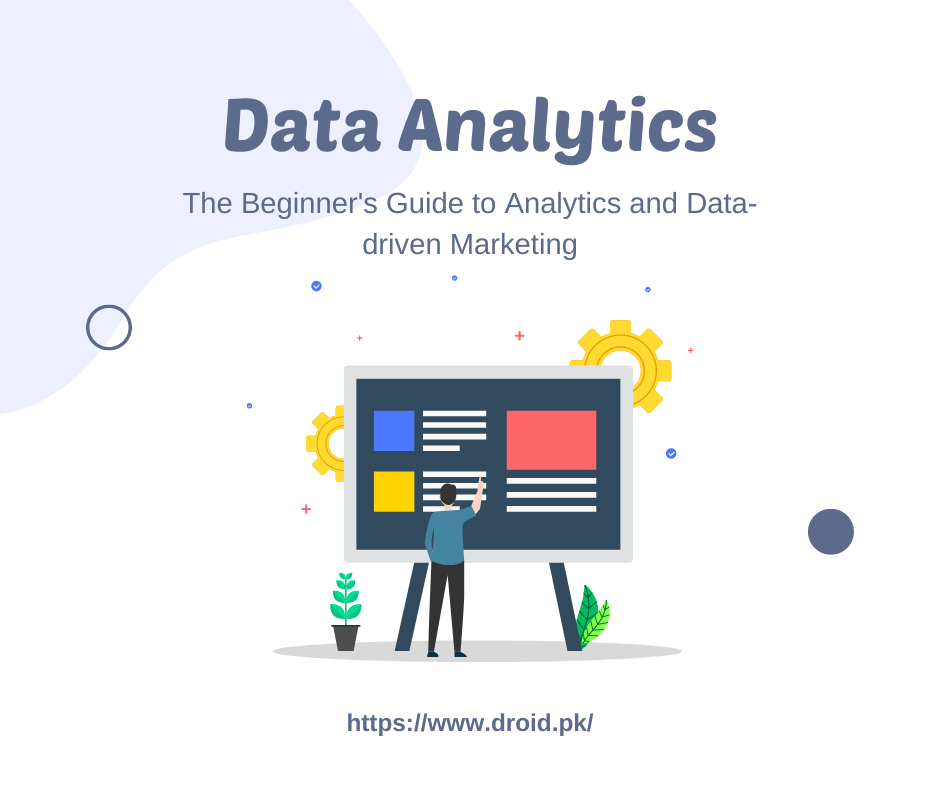
The Beginner's Guide to Analytics and Data-driven Marketing
Share
Introduction
In today's digital landscape, analytics and data-driven marketing have become essential for businesses seeking to gain a competitive edge and maximize their marketing efforts. By harnessing the power of data and analytics, marketers can make informed decisions, optimize campaigns, and drive better results. If you're new to analytics and data-driven marketing, this beginner's guide is here to help. We'll walk you through the fundamentals, best practices, and strategies to leverage data and analytics for effective marketing campaigns.
Table of Contents
- What is Analytics and Data-driven Marketing?
- The Benefits of Data-driven Marketing
- Setting Up Analytics Tools
- Understanding Key Metrics and KPIs
- Analyzing Customer Behavior
- Segmenting and Targeting Audiences
- Personalization and Customization
- A/B Testing and Conversion Optimization
- Attribution and Marketing ROI
- Predictive Analytics and Machine Learning
- Data Privacy and Compliance
- Data Visualization and Reporting
- Integrating Analytics with Marketing Platforms
- Creating Data-driven Content Strategies
- Leveraging Social Media Analytics
- Email Marketing Analytics
- Search Engine Marketing Analytics
- Mobile and App Analytics
- E-commerce Analytics
- Marketing Automation and Analytics
- Data-driven Decision Making
- Challenges and Solutions in Data-driven Marketing
- Ensuring Data Accuracy and Quality
- Ethical Use of Data in Marketing
- Conclusion
1. What is Analytics and Data-driven Marketing?
Analytics and data-driven marketing refer to the practice of using data and analytical insights to inform marketing strategies, campaigns, and decision-making processes. It involves collecting, analyzing, and interpreting data from various sources to gain valuable insights about customer behavior, preferences, and trends.
2. The Benefits of Data-driven Marketing
Data-driven marketing offers numerous benefits, including:
- Improved targeting and personalization
- Enhanced customer experience
- Increased campaign effectiveness and ROI
- Better understanding of customer behavior
- Optimized marketing strategies and resource allocation
3. Setting Up Analytics Tools
To embark on your data-driven marketing journey, you'll need to set up analytics tools to collect and analyze data. Popular analytics tools include Google Analytics, Adobe Analytics, and HubSpot. Follow these steps to get started:
- Choose the right analytics platform for your business.
- Set up an account and implement tracking codes on your website or app.
- Configure goals and events to measure desired actions.
- Customize your analytics settings to gather relevant data.
4. Understanding Key Metrics and KPIs
To effectively analyze your marketing performance, it's essential to understand key metrics and KPIs (Key Performance Indicators). Here are some common metrics to track:
- Website traffic: Total visits, unique visitors, and page views.
- Conversion rate: The percentage of visitors who complete a desired action.
- Bounce rate: The percentage of visitors who leave the site after viewing a single page.
- Average session duration: The average time visitors spend on your site.
- Click-through rate (CTR): The percentage of users who click on a specific link or ad.
5. Analyzing Customer Behavior
Analyzing customer behavior provides valuable insights into their preferences, interests, and purchasing patterns. Use tools like heatmaps, session recordings, and customer surveys to gain a deeper understanding of your audience. Analyze data on:
- Pages visited
- Time spent on each page
- Exit points
- Products or services viewed
- Conversion paths
6. Segmenting and Targeting Audiences
Segmenting your audience allows you to personalize your marketing messages and target specific groups with tailored content. Consider segmenting based on demographics, interests, behaviors, or past interactions with your brand. Use data to create targeted campaigns and deliver personalized experiences.
7. Personalization and Customization
Personalization and customization are key components of data-driven marketing. Leverage data to deliver personalized content, recommendations, and offers to your audience. Use dynamic content, email personalization, and website personalization tools to create tailored experiences that resonate with your customers.
8. A/B Testing and Conversion Optimization
A/B testing involves comparing two or more versions of a webpage or marketing campaign to determine which performs better. Use A/B testing to optimize your website, landing pages, email subject lines, ad copy, and other marketing elements. Analyze the results to make data-driven decisions and continuously improve conversion rates.
9. Attribution and Marketing ROI
Attribution allows you to determine the impact of each marketing channel on conversions and revenue. Use attribution models to allocate credit to touchpoints along the customer journey. By understanding the contribution of each channel, you can optimize your marketing mix and maximize ROI.
10. Predictive Analytics and Machine Learning
Predictive analytics and machine learning leverage historical data to forecast future trends, customer behavior, and outcomes. Use predictive models to identify potential opportunities, optimize marketing campaigns, and make data-driven predictions about customer actions.
11. Data Privacy and Compliance
Respecting customer privacy and complying with data protection regulations is crucial in data-driven marketing. Ensure you have proper consent mechanisms, data anonymization practices, and security measures in place. Familiarize yourself with regulations such as GDPR (General Data Protection Regulation) and CCPA (California Consumer Privacy Act).
12. Data Visualization and Reporting
Data visualization plays a vital role in conveying complex insights in a visually appealing and easily understandable format. Use data visualization tools and techniques to create charts, graphs, and dashboards that simplify data interpretation and aid in decision-making.
13. Integrating Analytics with Marketing Platforms
Integrating analytics with marketing platforms enhances your ability to collect and analyze data across various channels. Integrate your analytics tools with your email marketing software, CRM (Customer Relationship Management) system, and advertising platforms to gain a holistic view of your marketing efforts.
14. Creating Data-driven Content Strategies
Data-driven content strategies involve leveraging data insights to guide content creation, distribution, and optimization. Use data to identify topics of interest, determine the best content formats, and track content performance. Incorporate SEO strategies and keyword research to enhance content visibility and organic reach.
15. Leveraging Social Media Analytics
Social media analytics provide valuable insights into audience engagement, content performance, and social trends. Use social media analytics tools to track metrics such as follower growth, engagement rate, reach, and shares. Analyze this data to refine your social media strategies and improve campaign effectiveness.
16. Email Marketing Analytics
Email marketing analytics enable you to track the performance of your email campaigns, measure open rates, click-through rates, and conversion rates. Use A/B testing to optimize email subject lines, content, and CTAs (Call to Actions). Leverage analytics to segment your email list and personalize your email content.
17. Search Engine Marketing Analytics
Search engine marketing analytics help you measure the effectiveness of your paid search campaigns, such as Google Ads. Track metrics like click-through rates, conversion rates, and cost per acquisition. Analyze keyword performance and adjust your bidding strategy to maximize ROI.
18. Mobile and App Analytics
Mobile and app analytics provide insights into user behavior within your mobile apps. Trackmetrics such as app downloads, user engagement, retention rate, and in-app purchases. Use mobile analytics tools to identify user drop-off points, optimize the user experience, and drive app monetization.
19. E-commerce Analytics
For e-commerce businesses, e-commerce analytics are essential for understanding customer behavior, optimizing product offerings, and improving the overall shopping experience. Track metrics such as conversion rate, average order value, cart abandonment rate, and customer lifetime value. Utilize analytics data to personalize product recommendations and optimize the user journey.
20. Marketing Automation and Analytics
Marketing automation platforms can integrate analytics to track and measure the performance of automated marketing campaigns. Monitor metrics like lead generation, engagement rates, conversion rates, and customer journey progression. Use analytics insights to refine and improve your automated marketing workflows.
21. Data-driven Decision Making
Data-driven decision making involves using insights derived from data analysis to inform strategic marketing decisions. Combine data analysis with industry knowledge and expertise to make informed choices about campaign optimizations, budget allocations, and marketing strategies.
22. Challenges and Solutions in Data-driven Marketing
Data-driven marketing comes with its own set of challenges. Common challenges include data silos, data quality issues, privacy concerns, and the complexity of analyzing vast amounts of data. Solutions include implementing data integration strategies, ensuring data accuracy and consistency, prioritizing data privacy, and leveraging data visualization tools for easier interpretation.
23. Ensuring Data Accuracy and Quality
Data accuracy and quality are critical for reliable analysis and decision making. Implement data validation processes, perform regular data audits, and invest in data cleansing and enrichment techniques. Ensure data integrity and reliability by following best practices in data collection, storage, and management.
24. Ethical Use of Data in Marketing
Ethical use of data involves respecting user privacy, obtaining consent for data collection, and using data for legitimate and transparent purposes. Adhere to data protection regulations, maintain transparency in data practices, and prioritize data security to establish trust with your audience.
25. Conclusion
The Beginner's Guide to Analytics and Data-driven Marketing has provided you with a comprehensive overview of the fundamentals, strategies, and best practices in leveraging data and analytics for effective marketing campaigns. By harnessing the power of data, you can gain valuable insights into customer behavior, optimize marketing efforts, and drive better results. Embrace data-driven decision making, stay updated with evolving technologies, and continually refine your marketing strategies to thrive in the data-driven era.
FAQs
Q: What is the role of data in marketing? A: Data plays a crucial role in marketing by providing valuable insights into customer behavior, preferences, and trends. It allows marketers to make informed decisions, personalize marketing messages, optimize campaigns, and measure the effectiveness of marketing efforts.
Q: How can analytics improve marketing performance? A: Analytics enables marketers to measure and analyze the performance of marketing campaigns, track key metrics, and identify areas for improvement. By leveraging analytics insights, marketers can optimize their strategies, allocate resources effectively, and achieve better results.
Q: What are some common challenges in data-driven marketing? A: Common challenges in data-driven marketing include data silos, data quality issues, privacy concerns, and the complexity of analyzing large volumes of data. Overcoming these challenges requires implementing data integration strategies, ensuring data accuracy, prioritizing data privacy, and leveraging data visualization tools.
Q: How can I ensure data privacy and compliance in my marketing practices? A: To ensure data privacy and compliance, familiarize yourself with relevant regulations such as GDPR and CCPA. Obtain proper consent for data collection, implement security measures to protect data, and be transparent in your data practices. Prioritize data privacy to establish trust with your audience.
Q: How can I effectively analyze customer behavior using data? A: To analyze customer behavior, utilize tools such as heatmaps, session recordings, and customer surveys. Analyze data on pages visited, time spent on each page, exit points, and conversion paths. By understanding customer behavior, you can tailor your marketing strategies to better meet their needs.
Q: How can I leverage data to personalize marketing messages? A: Data allows you to segment your audience based on demographics, interests, and past interactions. Use this data to deliver personalized marketing messages, recommendations, and offers. Leverage dynamic content, email personalization, and website personalization tools to create tailored experiences.

